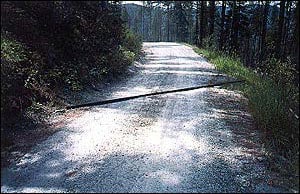A Landowner's Guide to Building Forest Access Road
How it Work!
- Register first and log into your account. Study and take the quiz for FREE until passed.
- After passing the quiz, follow the page, pay for the course and print your certificate.
Course Summary
This guide is designed for landowners in the northeastern United States who will use a tractor and ordinary earth moving equipment to build the simplest access roads on their property, or who will contract for these services. Logging roads on small woodland properties are usually constructed by the logging contractor, sawmill operator, or by a road contractor.

This guide applies to low-speed forest roads with a 12-foot-wide running surface that are needed only temporarily or only during certain times of the year. Recommendations in this guide cover basic planning, construction, drainage, maintenance, and closure of such forest roads. The recommendations incorporate best management practices, which are designed to reduce nonpoint-source pollution, as can occur during road building.
This guide also covers special situations involving water that require individual consideration: streams with or without migratory fish, beaver ponds, and wetlands. Each of these situations is covered in a separate section. Landowners should read each section that applies to their land.
Geotextiles are also described in a separate section. These synthetic permeable materials can be used during road building in a variety of ways, from providing standard drainage to performing specialized functions in wetlands. Using the information in this guide, landowners can complete road building projects to their satisfaction. They can also save on the cost of construction and future maintenance by understanding what is involved and by being able to provide information to a contractor.
Learning Objective:
The learning objective of this PDH course is to make the attendees familiarize with building of a slow speed 12 ft road during certain times of the year to an adjacent forest.
Course Author
Franco F. Davati, P.E
Review the quiz before studying the course.Certificate of completion of the course
This course comes with a multiple-choice quiz. You can view the quiz and take the quiz if you are logged in your account. You can take the quiz for this online PDH course as many times until passed. The passing grade is 70% and above. After you pass the quiz simply follow the page, to pay for the course and print your certificate instantly. A copy of the certificate and receipt for this course will always be in your account.Acrobat Reader is required to view this document. Click here to download a free copy of Acrobat Reader.
This online PDH course can also be used as a continuing education course for the following.

